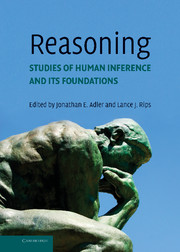Book contents
- Frontmatter
- Contents
- Preface
- List of Contributors
- Introduction: Philosophical Foundations
- PART I FOUNDATIONS OF REASONING
- PART II MODES OF REASONING
- Section 3 Deductive Reasoning
- 9 Logical Approaches to Human Deductive Reasoning
- 10 Mental Models and Deductive Reasoning
- 11 Interpretation, Representation, and Deductive Reasoning
- 12 Reasoning with Quantifiers
- 13 The Problem of Deduction
- Section 4 Induction
- Section 5 Dual and Integrative Approaches
- Section 6 Abduction and Belief Change
- Section 7 Causal and Counterfactual Reasoning
- Section 8 Argumentation
- PART II INTERACTIONS OF REASONING IN HUMAN THOUGHT
- Index
- References
10 - Mental Models and Deductive Reasoning
Published online by Cambridge University Press: 05 June 2012
- Frontmatter
- Contents
- Preface
- List of Contributors
- Introduction: Philosophical Foundations
- PART I FOUNDATIONS OF REASONING
- PART II MODES OF REASONING
- Section 3 Deductive Reasoning
- 9 Logical Approaches to Human Deductive Reasoning
- 10 Mental Models and Deductive Reasoning
- 11 Interpretation, Representation, and Deductive Reasoning
- 12 Reasoning with Quantifiers
- 13 The Problem of Deduction
- Section 4 Induction
- Section 5 Dual and Integrative Approaches
- Section 6 Abduction and Belief Change
- Section 7 Causal and Counterfactual Reasoning
- Section 8 Argumentation
- PART II INTERACTIONS OF REASONING IN HUMAN THOUGHT
- Index
- References
Summary
How do people reason? The view that I learned at my mother's knee was that they rely on logic. During the 1960s and 1970s when the study of thinking had become respectable again after the Dark Ages of Behaviorism, psychologists – including the present author – took this view for granted. The idea that logic provided the norms of reasoning can be traced back to the rise of modern logic, and was defended in the nineteenth century by both Boole (1854) and Mill (1874). In the twentieth century, the Swiss psychologist, Jean Piaget, and his colleagues argued that the construction of a formal logic in the mind was the last great step in children's intellectual development, and that it occurred at about the age of twelve (see, e.g., Inhelder and Piaget, 1958). And so thirty years ago the task for psychologists appeared to be to determine which particular formal logic was laid down in the mind and which particular rules of inference were used in its mental formulation. That, at least, was how several like-minded authors conceived their research (see, e.g., Osherson 1974–1976; Johnson-Laird 1975; Braine 1978; Rips 1983). In the parallel “universe” of artificial intelligence, researchers were similarly developing computer programs that proved theorems relying on formal rules of inference (e.g., Bledsoe 1977). The main skeptics were those engaged in trying to analyze everyday arguments. They discovered that it was extraordinarily difficult to translate such arguments into formal logic.
- Type
- Chapter
- Information
- ReasoningStudies of Human Inference and its Foundations, pp. 206 - 222Publisher: Cambridge University PressPrint publication year: 2008
References
- 25
- Cited by



